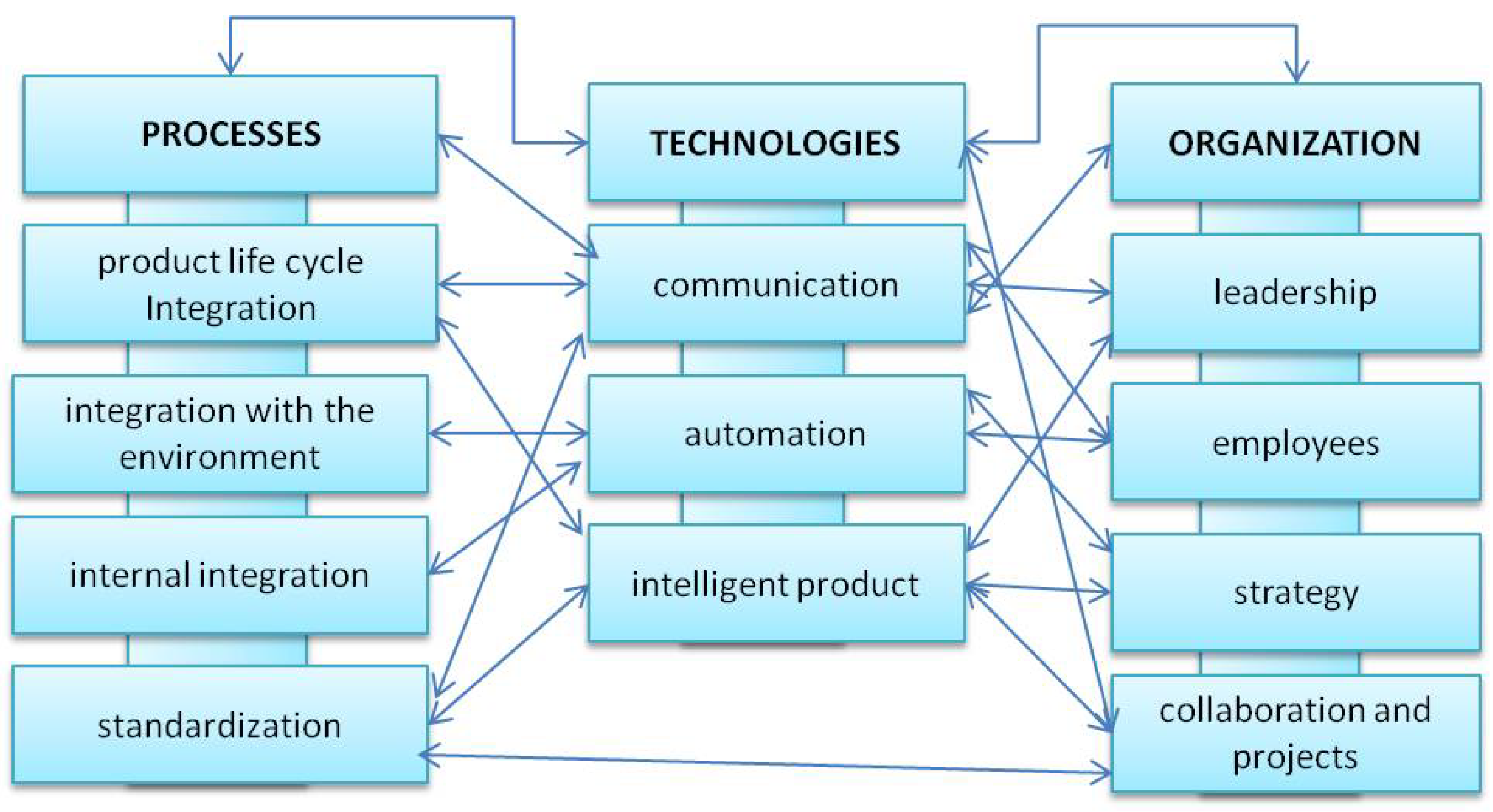Analysis of Directional Activities for Industry 4.0 in the Example of Poland and Germany
Abstract
:1. Introduction
- (1)
- What are the directional measures for Industry 4.0, taking the example of Poland and Germany?
- (2)
- What are the areas of development based on the transformation map and potential directions of automation and robotization?
- (3)
- What is a reliable source indicating technological development? Do automation and robotization indicate development in this area?
- (4)
- What is the awareness of the implemented features that confirm the fulfillment of conditions relating to Industry 4.0?
- (5)
- Are there any activities aimed at the sustainable replacement of machines that require repair or regeneration related to rationalization of undertaken activities and assessment of the financial possibilities of companies so as not to lead to their collapse?
2. Materials and Methods
Characteristics of the Industry and Its Development in the Context of Industry 4.0
3. Analysis of Technological Possibilities in the World
4. Result
Characteristics of Original Research Aimed at Digital Maturity of Selected Production Companies in Poland and Germany
5. Discussion
6. Conclusions
Author Contributions
Funding
Institutional Review Board Statement
Informed Consent Statement
Data Availability Statement
Conflicts of Interest
References
- Maresova, P.; Soukal, I.; Svobodova, L.; Hedvicakova, M.; Javanmardi, E.; Selamat, A.; Krejcar, O. Consequences of industry 4.0 in business and economics. Economies 2018, 6, 46. [Google Scholar]
- Klöpper, B.; Pater, J.; Dangelmaier, W. Parallel scheduling for evolving manufacturing systems. In Proceedings of the 9th IEEE International Conference on Industrial Informatics, Beijing, China, 25–27 July 2012; pp. 1086–1091. [Google Scholar]
- Culot, G.; Nassimbeni, G.; Orzes, G.; Sartor, M. Behind the definition of Industry 4.0: Analysis and open questions. Int. J. Prod. Econ. 2020, 226, 107617. [Google Scholar]
- Vaidya, S.; Ambad, P.; Bhosle, S. Industry 4.0—A glimpse. Proc. Manuf. 2018, 20, 233–238. [Google Scholar]
- Luthra, S.; Mangla, S.K. Evaluating challenges to Industry 4.0 initiatives for supply chain sustainability in emerging economies. Process Saf. Environ. Prot. 2018, 117, 168–179. [Google Scholar]
- Lasi, H.; Fettke, P.; Kemper, H.G.; Feld, T.; Hoffmann, M. Industry 4.0. Bus. Inf. Syst. Eng. 2014, 6, 239–242. [Google Scholar]
- Ghobakhloo, M. Industry 4.0, digitization, and opportunities for sustainability. J. Clean. Prod. 2020, 252, 119869. [Google Scholar]
- Magruk, A. Uncertainty in the sphere of the industry 4.0–potential areas to research. Bus. Manag. Educ. 2016, 14, 275–291. [Google Scholar]
- Tupa, J.; Simota, J.; Steiner, F. Aspects of risk management implementation for Industry 4.0. Proc. Manuf. 2017, 11, 1223–1230. [Google Scholar]
- Stock, T.; Seliger, G. Opportunities of sustainable manufacturing in industry 4.0. Proc. CIRP 2016, 40, 536–541. [Google Scholar]
- Li, D.; Fast-Berglund, Å.; Paulin, D. Current and future Industry 4.0 capabilities for information and knowledge sharing. Int. J. Adv. Manuf. Technol. 2019, 105, 3951–3963. [Google Scholar]
- Ciffolilli, A.; Muscio, A. Industry 4.0: National and regional comparative advantages in key enabling technologies. Eur. Plan. Stud. 2018, 26, 2323–2343. [Google Scholar]
- Bal, H.Ç.; Erkan, Ç. Industry 4.0 and competitiveness. Proc. Comput. Sci. 2019, 158, 625–631. [Google Scholar]
- Model Industrial Ranking Digitalization. Available online: https://www.smart-energy.com/digitalisation/bnef-rank-top-digitalization-markets/ (accessed on 3 August 2021).
- Lee, J.Y.; Kim, K.I. An Exploratory Study to Respond to Industry 4.0 Dysfunction in Small and Medium Manufacturers. J. Conver. Inf. Technol. 2018, 8, 169–174. [Google Scholar]
- Maisiri, W.; Darwish, H.; Van Dyk, L. An investigation of Industry 4.0 skills requirements. S. Afr. J. Ind. Eng. 2019, 30, 90–105. [Google Scholar]
- Ghobakhloo, M. The future of manufacturing industry: A strategic roadmap toward Industry 4.0. J. Manuf. Technol. Manag. 2018, 29, 910–936. [Google Scholar]
- Lele, A. Industry 4.0. In Disruptive Technologies for the Militaries and Security; Springer: Singapore, 2019; pp. 205–215. [Google Scholar]
- Tuyishime, C.R.; Nzanywayingoma, F.; Gatera, O. IoT-based Intelligent Energy Efficiency Management System for Smart Industries (IoT-IEEMS). In Proceedings of the 2021 IEEE International Conference on Industry 4.0, Artificial Intelligence, and Communications Technology, IAICT, Bandung, Indonesia, 27–28 July 2021; IEEE: Piscataway, NJ, USA, 2021; pp. 248–254. [Google Scholar]
- Kaur, R.; Awasthi, A. City logistics: A review and bibliometric analysis. Int. J. Bibliometrics Bus. Manag. 2018, 1, 160–188. [Google Scholar]
- Stăncioiu, A. The fourth industrial revolution “Industry 4.0”. Fiabil. Durabilitate 2017, 1, 74–78. [Google Scholar]
- Hozdić, E. Smart factory for industry 4.0: A review. Int. J. Mod. Manuf. Technol. 2015, 7, 28–35. [Google Scholar]
- What Is Industry 4.0? Available online: www.insights.sap.com/what-is-industry// (accessed on 3 August 2021).
- Ibarra, D.; Bigdeli, A.Z.; Igartua, J.I.; Ganzarain, J. Business model innovation in established SMEs: A configurational approach. J. Open Innov. Technol. Mark. Complex. 2020, 6, 76. [Google Scholar]
- Davidson, R. Cyber-physical production networks, artificial intelligence-based decision-making algorithms, and big data-driven innovation in Industry 4.0-based manufacturing systems. Econ. Manag. Financ. Mark. 2020, 15, 16–22. [Google Scholar]
- Büchi, G.; Cugno, M.; Castagnoli, R. Smart factory performance and Industry 4.0. Technol. Forecast. Soc. Chang. 2020, 150, 119790. [Google Scholar]
- Faheem, M.; Shah, S.B.H.; Butt, R.A.; Raza, B.; Anwar, M.; Ashraf, M.W.; Ngadi, M.A.; Gungor, V.C. Smart grid communication and information technologies in the perspective of Industry 4.0: Opportunities and challenges. Comput. Sci. Rev. 2018, 30, 1–30. [Google Scholar]
- Hecklau, F.; Galeitzke, M.; Flachs, S.; Kohl, H. Holistic approach for human resource management in Industry 4.0. Proc. CIRP 2016, 54, 1–6. [Google Scholar]
- Popkova, E.G.; Sergi, B.S. Human capital and AI in industry 4.0. Convergence and divergence in social entrepreneurship in Russia. J. Intellect. Cap. 2020, 21, 565–581. [Google Scholar]
- Sanghavi, D.; Parikh, S.; Raj, S.A. Industry 4.0: Tools and implementation. Manag. Prod. Eng. Rev. 2019, 10, 3–13. [Google Scholar]
- Pejic-Bach, M.; Bertoncel, T.; Meško, M.; Krstić, Ž. Text mining of industry 4.0 job advertisements. Int. J. Inf. Manag. 2020, 50, 416–431. [Google Scholar]
- Li, Z.; Wang, Y.; Wang, K.S. Intelligent predictive maintenance for fault diagnosis and prognosis in machine centers: Industry 4.0 scenario. Adv. Manuf. 2017, 5, 377–387. [Google Scholar]
- Sony, M.; Naik, S. Industry 4.0 integration with socio-technical systems theory: A systematic review and proposed theoretical model. Technol. Soc. 2020, 61, 101248. [Google Scholar]
- Zaidin, N.H.M.; Diah, M.N.M.; Yee, P.H.; Sorooshian, S. Quality management in industry 4.0 era. J. Manag. Sci. 2018, 8, 82–91. [Google Scholar]
- Moktadir, M.A.; Ali, S.M.; Kusi-Sarpong, S.; Shaikh, M.A.A. Assessing challenges for implementing Industry 4.0: Implications for process safety and environmental protection. Process Saf. Environ. Prot. 2018, 117, 730–741. [Google Scholar]
- ALNEA. Tech Me Czyli Roboty do Roboty w Naszym Techroomie—ALNEA. Available online: www.alneatech.pl/tech=me (accessed on 4 August 2021).
- Almadani, Y.; Plets, D.; Bastiaens, S.; Joseph, W.; Ijaz, M.; Ghassemlooy, Z.; Rajbhandari, S. Visible light communications for industrial applications—Challenges and potentials. Electronics 2020, 9, 2157. [Google Scholar]
- Prinsloo, J.; Sinha, S.; von Solms, B. A review of industry 4.0 manufacturing process security risks. Appl. Sci. 2019, 9, 5105. [Google Scholar]
- Ardito, L.; Petruzzelli, A.M.; Panniello, U.; Garavelli, A.C. Towards Industry 4.0: Mapping digital technologies for supply chain management-marketing integration. Bus. Process Manag. J. 2018, 25, 323–346. [Google Scholar]
- Lassnig, M.; Müller, J.M.; Klieber, K.; Zeisler, A.; Schirl, M. A digital readiness check for the evaluation of supply chain aspects and company size for Industry 4.0. J. Manuf. Technol. Manag. 2021; ahead-of-print. [Google Scholar]
- Emerson Introduces Digital Maturity Tool to Help Companies Target Digital Transformation Priorities. Available online: https://www.industryemea.com/news/37448-emerson-introduces-digital-maturity-tool-to-help-companies-target-digital-transformation-priorities (accessed on 4 August 2021).
- Annual Installations of Industrial Robots—World. Available online: https://ifr.org/downloads/press2018/Forecast_installations_WR2021.jpg (accessed on 3 August 2021).
- Robot Density in the Manufacturing Industry 2020. Available online: https://ifr.org/ifr-press-releases/news/ifr-forecast-1.7-million-new-robots-to-transform-the-worlds-factories-by-20 (accessed on 8 August 2021).
- Annual Installations of Industrial Robots 2015–2020 and 2021–2024. Available online: https://www.statista.com/statistics/264084/worldwide-sales-of-industrial-robots/ (accessed on 5 August 2021).
- Annual Installations of Industrial Robots (1000 Units). Available online: https://www.therobotreport.com/top-5-industrial-robotics-markets-worldwide/ (accessed on 3 August 2021).
- Industrial Digitalization: National Strategies and Ranking. Available online: https://infotechlead.com/iot/top-10-industrial-digital-transformation-countries-in-2020-62948 (accessed on 3 August 2021).
- Bloomberg NEF’s Country Ranking Reveals Models of Industrial Digitalization. Available online: https://about.bnef.com/blog/bloombergnefs-country-ranking-reveals-models-industrial-digitalization/ (accessed on 3 August 2021).
- Driving Innovation and New Business Models through Industry 4.0. Available online: https://www2.deloitte.com/cn/en/pages/energy-and-resources/articles/industry-4-0-business-models.html (accessed on 3 August 2021).
- Bai, C.; Dallasega, P.; Orzes, G.; Sarkis, J. Industry 4.0 technologies assessment: A sustainability perspective. Int. J. Prod. Econ. 2020, 229, 107776. [Google Scholar]
- Marcon, P.; Zezulka, F.; Vesely, I.; Szabo, Z.; Roubal, Z.; Sajdl, O.; Gescheidtova, E.; Dohnal, P. Communication technology for industry 4.0. In Proceedings of the 2017 Progress in Electromagnetics Research Symposium—Spring (PIERS), St. Petersburg, Russia, 22–25 May 2017; IEEE: Piscataway, NJ, USA, 2017; pp. 1694–1697. [Google Scholar]
- Wagner, T.; Herrmann, C.; Thiede, S. Industry 4.0 impacts on lean production systems. Proc. CIRP 2017, 63, 125–131. [Google Scholar]
- Sanders, A.; Elangeswaran, C.; Wulfsberg, J.P. Industry 4.0 implies lean manufacturing: Research activities in industry 4.0 function as enablers for lean manufacturing. J. Ind. Eng. Manag. 2016, 9, 811–833. [Google Scholar]
- Ustundag, A.; Cevikcan, E. Industry 4.0: Managing the Digital Transformation; Springer: Berlin/Heidelberg, Germany, 2017. [Google Scholar]
- Rossit, D.A.; Toncovich, A.A.; Rossit, D.G.; Nesmachnow, S. Operation Skipping Flow Shop Scheduling and Industry 4.0. Available online: https://www.matematica.uns.edu.ar/ipcra/pdf/icpr_americas_2020_proceedings.pdf (accessed on 3 August 2021).
- Hulla, M.; Karre, H.; Hammer, M.; Ramsauer, C. A teaching concept towards digitalization at the LEAD factory of Graz University of Technology. In Proceedings of the International Conference on Interactive Collaborative Learning, Kos Island, Greece, 25–28 September 2018; Springer: Cham, Switzerland, 2018; pp. 393–402. [Google Scholar]
- Xu, L.D.; Xu, E.L.; Li, L. Industry 4.0: State of the art and future trends. Int. J. Prod. Res. 2018, 56, 2941–2962. [Google Scholar]
- Veile, J.W.; Schmidt, M.C.; Müller, J.M.; Voigt, K.I. Relationship follows technology! How Industry 4.0 reshapes future buyer-supplier relationships. J. Manuf. Technol. Manag. 2020, 32, 1245–1266. [Google Scholar]
- Tjahjono, B.; Esplugues, C.; Ares, E.; Pelaez, G. What does industry 4.0 mean to supply chain? Proc. Manuf. 2017, 13, 1175–1182. [Google Scholar]
- Cañas, H.; Mula, J.; Díaz-Madroñero, M.; Campuzano-Bolarín, F. Implementing Industry 4.0 principles. Comput. Ind. Eng. 2021, 158, 107379. [Google Scholar]
- Majstorovic, V.D.; Mitrovic, R. Industry 4.0 programs worldwide. In Proceedings of the International Conference on the Industry 4.0 Model for Advanced Manufacturing, Belgrade, Serbia, 3–6 June 2019; Springer: Cham, Switzerland, 2019; pp. 78–99. [Google Scholar]
- Hizam-Hanafiah, M.; Soomro, M.A.; Abdullah, N.L. Industry 4.0 readiness models: A systematic literature review of model dimensions. Information 2020, 11, 364. [Google Scholar]
- Neumann, W.P.; Winkelhaus, S.; Grosse, E.H.; Glock, C.H. Industry 4.0 and the human factor—A systems framework and analysis methodology for successful development. Int. J. Prod. Econ. 2021, 233, 107992. [Google Scholar]
- Bochulia, T. Digital business transformation: Trends, innovative models, a development program. E3S Web Conf. EDP Sci. 2021, 307, 1–16. [Google Scholar]
- Cozzolino, A.; Verona, G.; Rothaermel, F.T. Unpacking the disruption process: New technology, business models, and incumbent adaptation. J. Manag. Stud. 2018, 55, 1166–1202. [Google Scholar]
- Grabowska, S.; Saniuk, S. Business Models in the Industry 4.0 Environment—Results of Web of Science Bibliometric Analysis. J. Open Innov. Technol. Market Complex. 2022, 8, 19. [Google Scholar]
- Almada-Lobo, F. The Industry 4.0 revolution and the future of Manufacturing Execution Systems (MES). J. Innov. Manag. 2015, 3, 16–21. [Google Scholar]
- Schlechtendahl, J.; Keinert, M.; Kretschmer, F.; Lechler, A.; Verl, A. Making existing production systems Industry 4.0-ready. Prod. Eng. 2015, 9, 143–148. [Google Scholar]
- Hofmann, E.; Sternberg, H.; Chen, H.; Pflaum, A.; Prockl, G. Supply chain management and Industry 4.0: Conducting research in the digital age. Int. J. Phys. Distrib. Logist. Manag. 2019, 49, 945–955. [Google Scholar]
- Khanzode, A.G.; Sarma, P.R.; Mangla, S.K.; Yuan, H. Modeling the Industry 4.0 adoption for sustainable production in Micro, Small & Medium Enterprises. J. Clean. Prod. 2021, 279, 123489. [Google Scholar]
- Gottge, S.; Menzel, T.; Forslund, H. Industry 4.0 technologies in the purchasing process. Ind. Manag. Data Syst. 2020, 120, 730–748. [Google Scholar]
- Zheng, P.; Wang, H.; Sang, Z.; Zhong, R.Y.; Liu, Y.; Liu, C.; Mubarok, K.; Yu, S.; Xu, X. Smart manufacturing systems for Industry 4.0: Conceptual framework, scenarios, and future perspectives. Front. Mech. Eng. 2018, 13, 137–150. [Google Scholar]
- Santos, R.C.; Martinho, J.L. An Industry 4.0 maturity model proposal. J. Manuf. Technol. Manag. 2019, 31, 1023–1043. [Google Scholar]
- Coşkun, S.; Kayıkcı, Y.; Gençay, E. Adapting engineering education to industry 4.0 vision. Technologies 2019, 7, 10. [Google Scholar]
- Zhang, C.; Chen, Y. A review of research relevant to the emerging industry trends: Industry 4.0, IoT, blockchain, and business analytics. J. Ind. Integr. Manag. 2020, 5, 165–180. [Google Scholar]
- Dalenogare, L.S.; Benitez, G.B.; Ayala, N.F.; Frank, A.G. The expected contribution of Industry 4.0 technologies for industrial performance. Int. J. Prod. Econ. 2018, 204, 383–394. [Google Scholar]
- Qin, J.; Liu, Y.; Grosvenor, R. A categorical framework of manufacturing for industry 4.0 and beyond. Proc. CIRP 2016, 52, 173–178. [Google Scholar]
- Zhong, R.Y.; Xu, X.; Klotz, E.; Newman, S.T. Intelligent manufacturing in the context of industry 4.0: A review. Engineering 2017, 3, 616–630. [Google Scholar]
- Gunal, M.M. Simulation for the Better: The Future in Industry 4.0. In Simulation for Industry 4.0; Springer: Cham, Switzerland, 2019; pp. 275–283. [Google Scholar]
- Zhou, K.; Liu, T.; Zhou, L. Industry 4.0: Towards future industrial opportunities and challenges. In Proceedings of the 2015 12th International Conference on Fuzzy Systems and Knowledge Discovery (FSKD), Zhangjiajie, China, 15–17 August 2015; pp. 2147–2152. [Google Scholar]
- Arantes, M.; Bonnard, R.; Mattei, A.P.; de Saqui-Sannes, P. General architecture for data analysis in industry 4.0 using SysML and model based system engineering. In Proceedings of the 2018 Annual IEEE international systems conference (SysCon), Vancouver, BC, Canada, 23–26 April 2018; pp. 1–6. [Google Scholar]
- Raptis, T.P.; Passarella, A.; Conti, M. Data management in industry 4.0: State of the art and open challenges. IEEE Access 2019, 7, 97052–97093. [Google Scholar]
- Benitez, G.B.; Ayala, N.F.; Frank, A.G. Industry 4.0 innovation ecosystems: An evolutionary perspective on value cocreation. Int. J. Prod. Econ. 2020, 228, 107735. [Google Scholar]
- Belinski, R.; Peixe, A.M.; Frederico, G.F.; Garza-Reyes, J.A. Organizational learning and Industry 4.0: Findings from a systematic literature review and research agenda. Benchmarking Int. J. 2020, 27, 2435–2457. [Google Scholar]
- Müller, J.M. Business model innovation in small-and medium-sized enterprises: Strategies for industry 4.0 providers and users. J. Manuf. Technol. Manag. 2019, 30, 1127–1142. [Google Scholar]
- Saucedo-Martínez, J.A.; Pérez-Lara, M.; Marmolejo-Saucedo, J.A.; Salais-Fierro, T.E.; Vasant, P. Industry 4.0 framework for management and operations: A review. J. Ambient Intell. Humaniz. Comput. 2018, 9, 789–801. [Google Scholar]
- Bortolini, M.; Ferrari, E.; Gamberi, M.; Pilati, F.; Faccio, M. Assembly system design in the Industry 4.0 era: A general framework. IFAC Pap. 2017, 50, 5700–5705. [Google Scholar]
- Cheng, G.J.; Liu, L.T.; Qiang, X.J.; Liu, Y. Industry 4.0 development and application of intelligent manufacturing. In Proceedings of the 2016 International Conference on Information System and Artificial Intelligence (ISAI), Hong Kong, China, 24–26 June 2016; pp. 407–410. [Google Scholar]
- Strange, R.; Zucchella, A. Industry 4.0, global value chains and international business. Multinatl. Bus. Rev. 2017, 25, 174–184. [Google Scholar]
- Glistau, E.; Coello Machado, N.I. Industry 4.0, logistics 4.0 and materials-Chances and solutions. Mater. Sci. Forum 2018, 919, 307–314. [Google Scholar]
- Fettermann, D.C.; Cavalcante, C.G.S.; Almeida, T.D.D.; Tortorella, G.L. How does Industry 4.0 contribute to operations management? J. Ind. Prod. Eng. 2018, 35, 255–268. [Google Scholar]
- Bonnard, R.; Arantes MD, S.; Lorbieski, R.; Vieira KM, M.; Nunes, M.C. Big data/analytics platform for Industry 4.0 implementation in advanced manufacturing context. Int. J. Adv. Manufac. Technol. 2021, 117, 1959–1973. [Google Scholar]
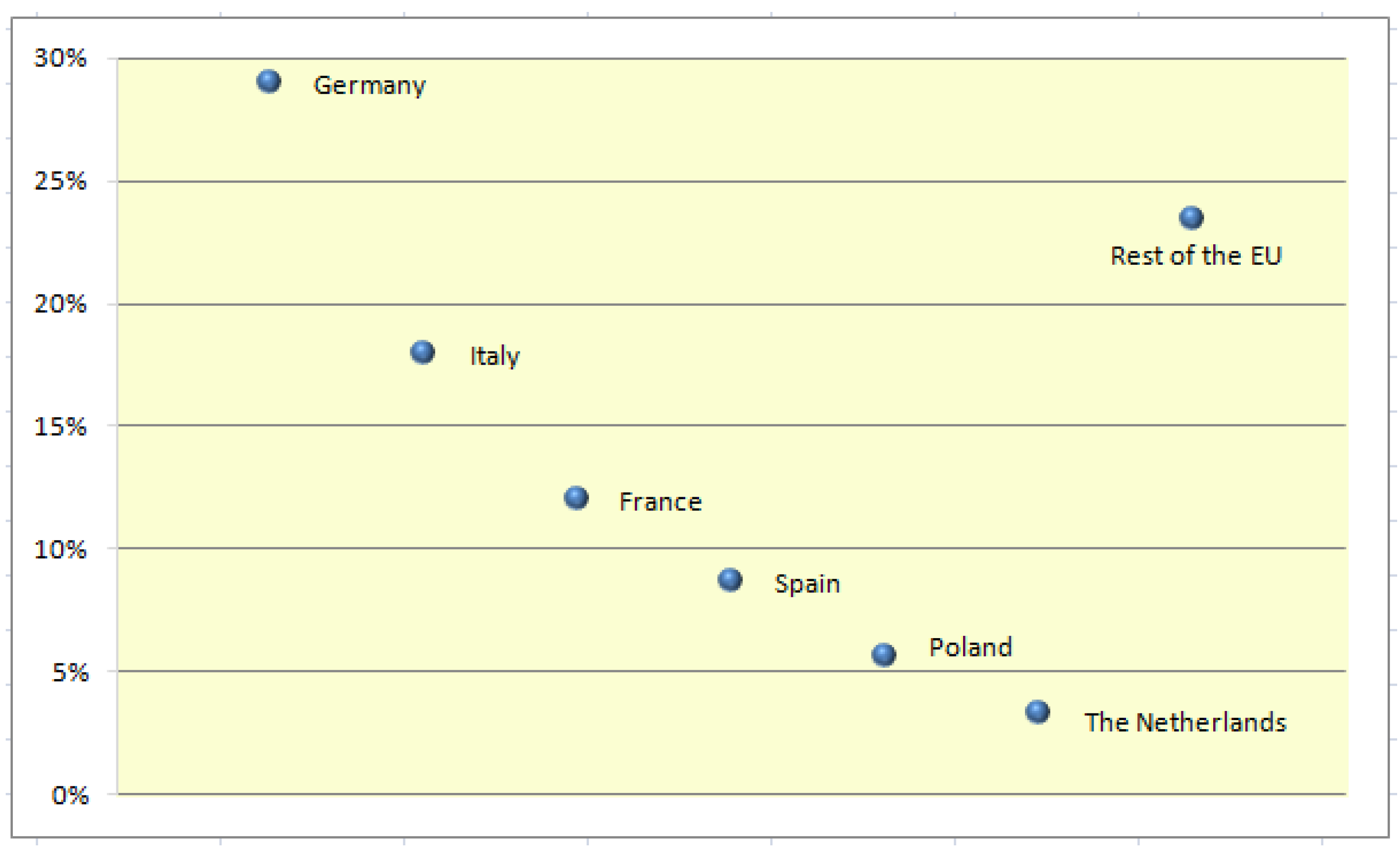

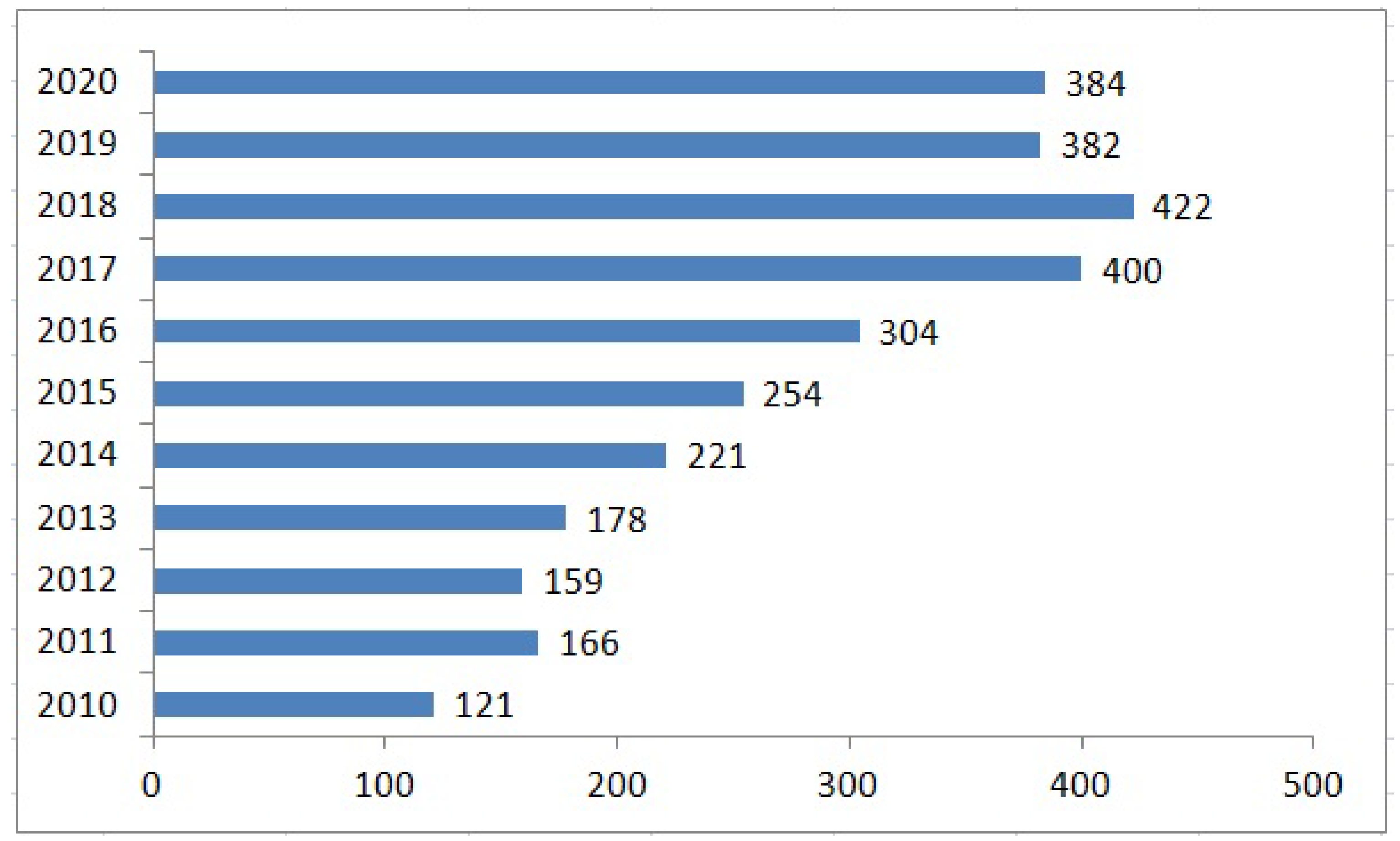

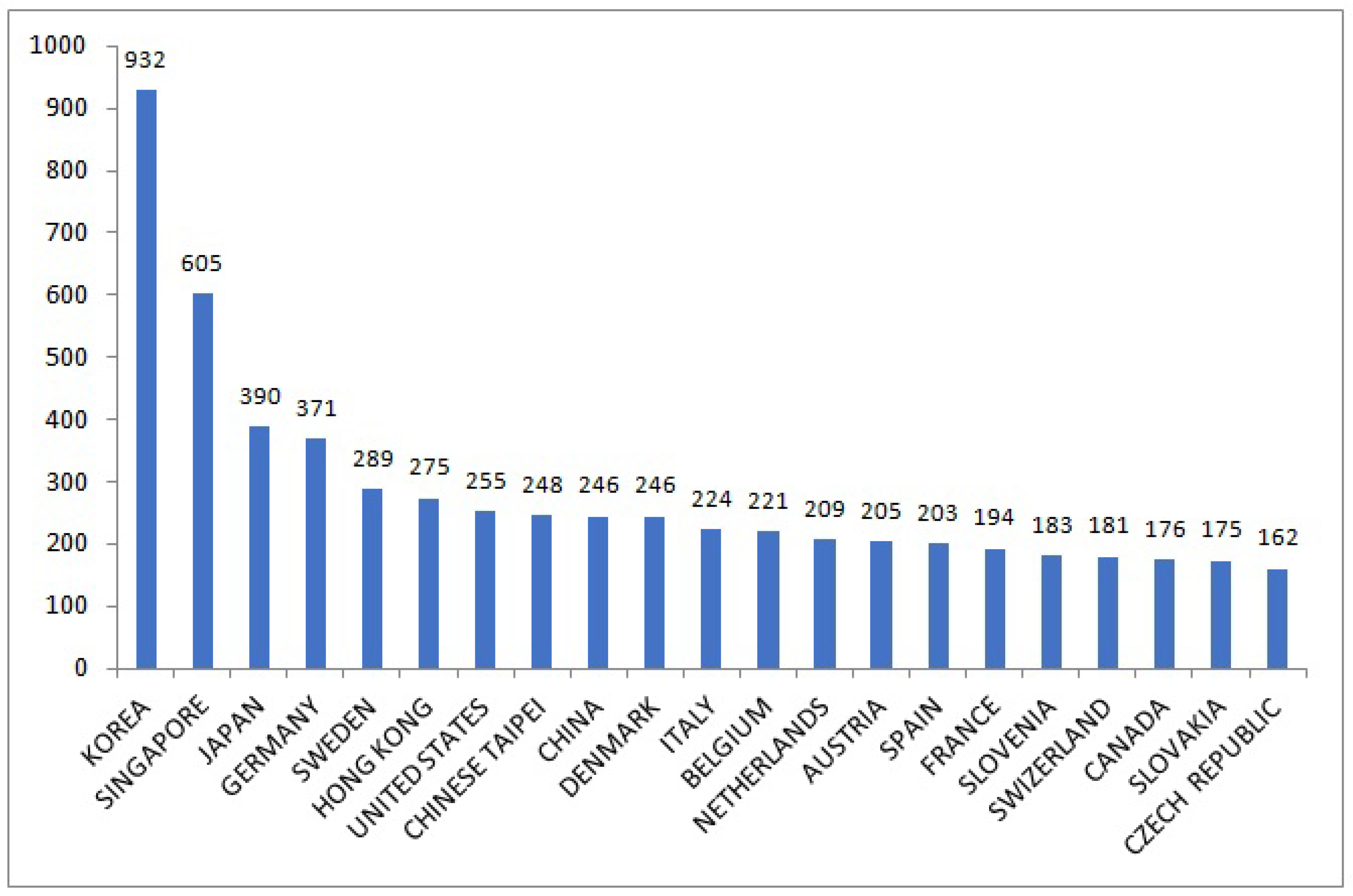


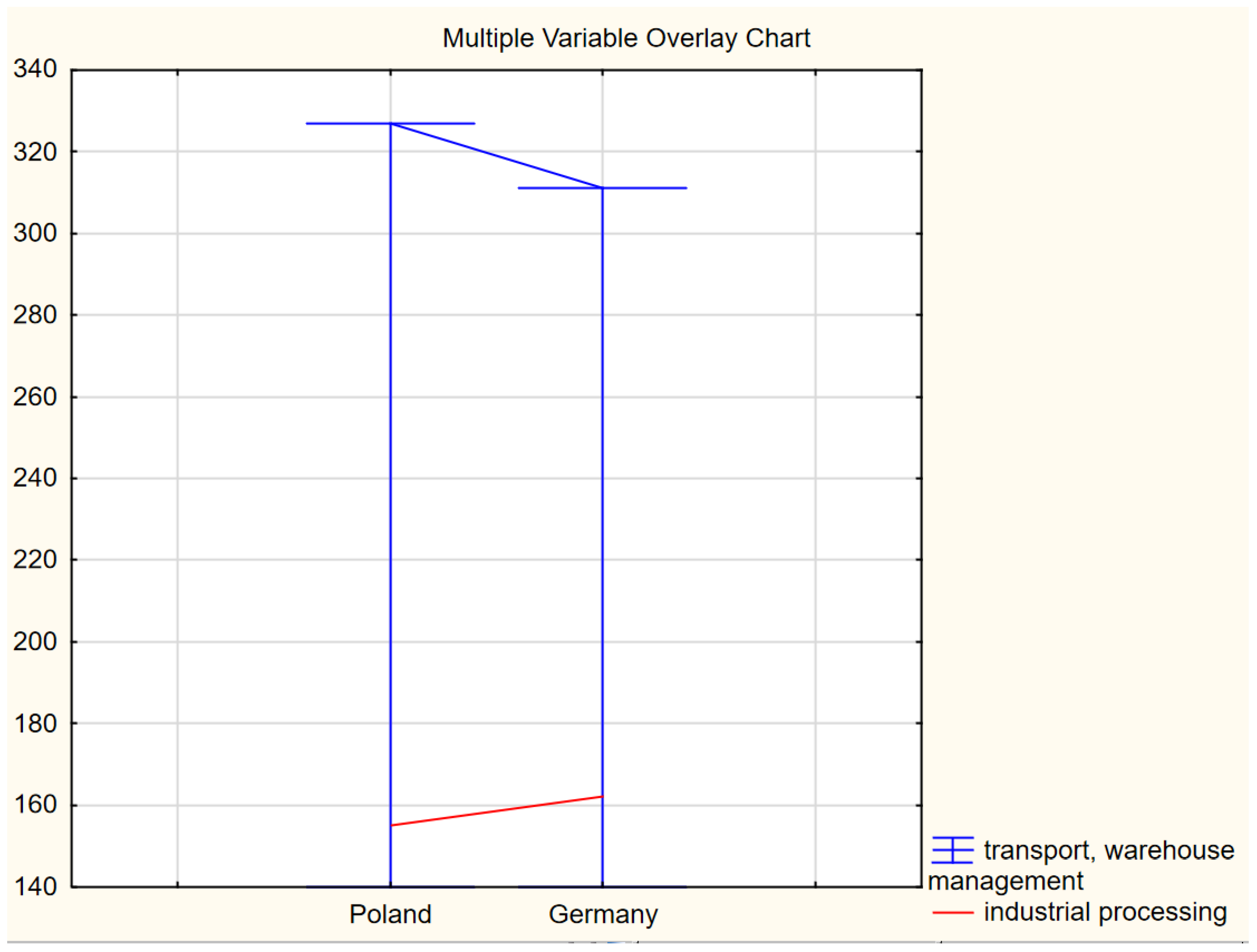
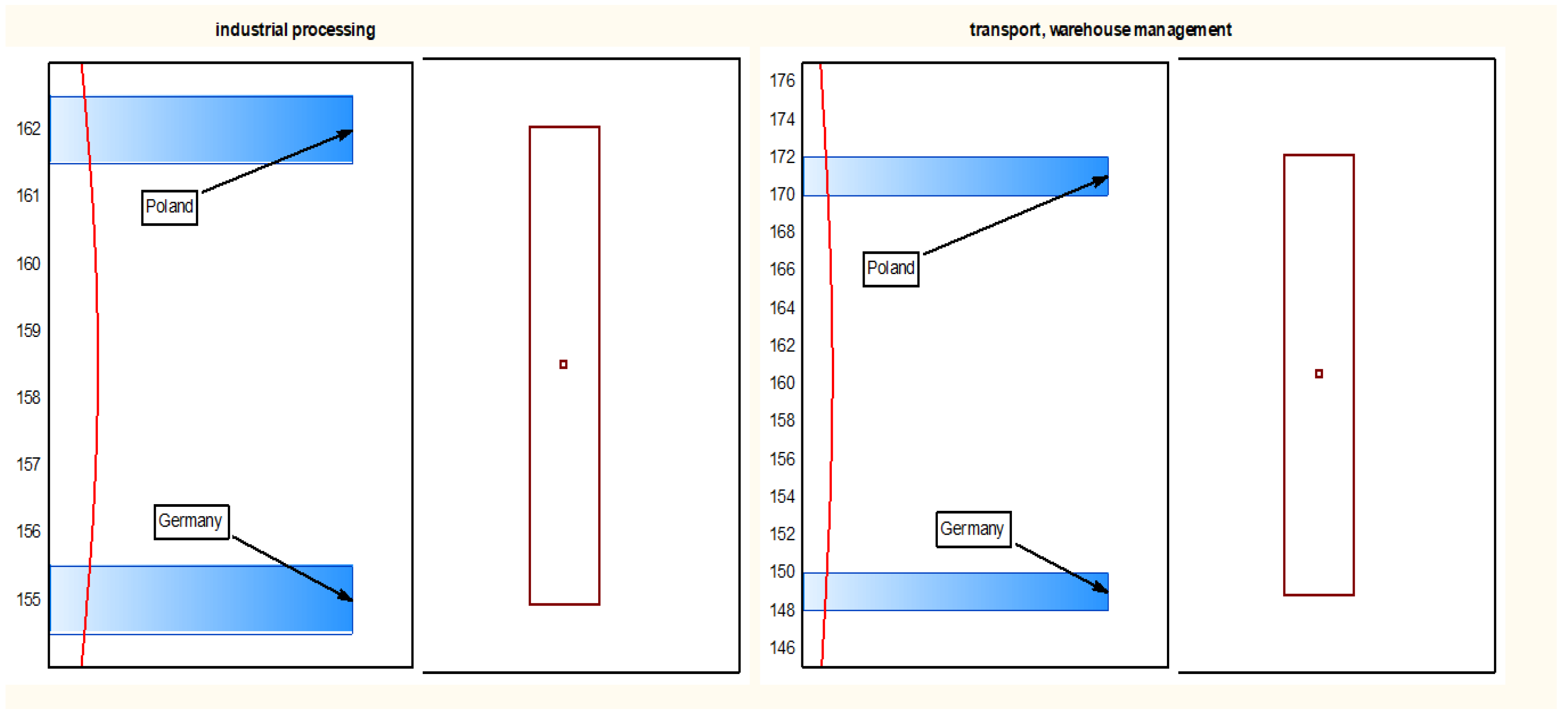
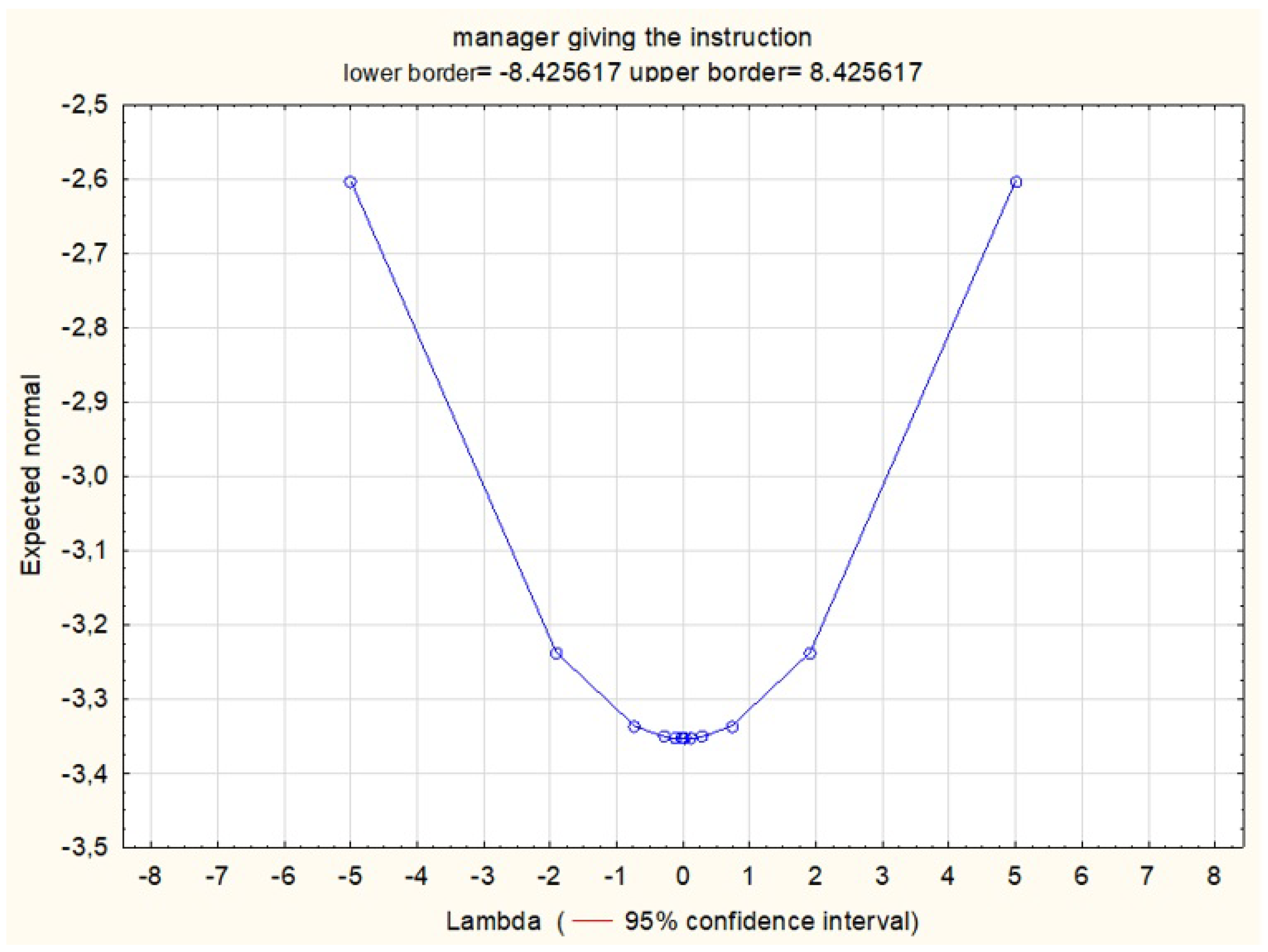

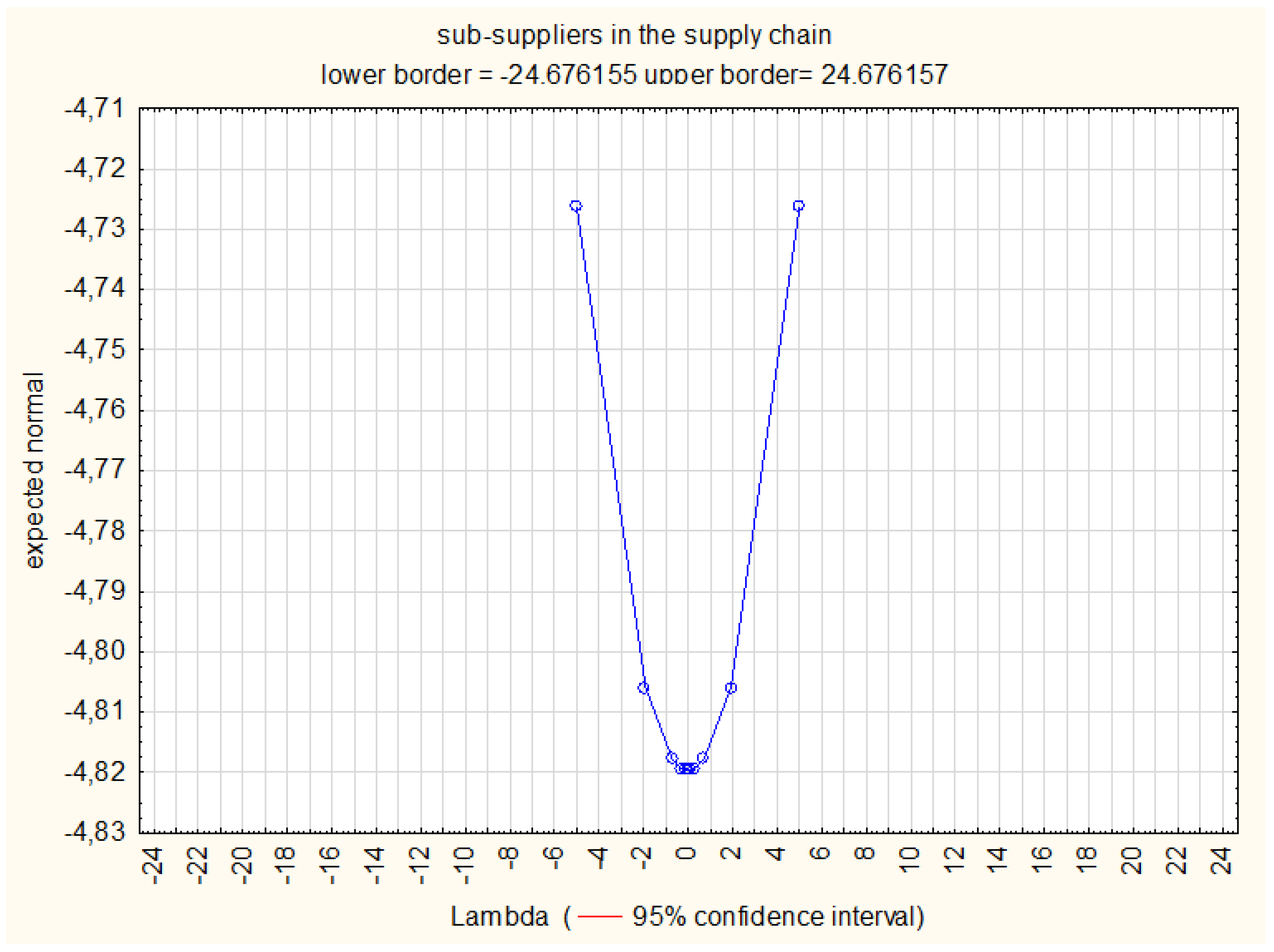
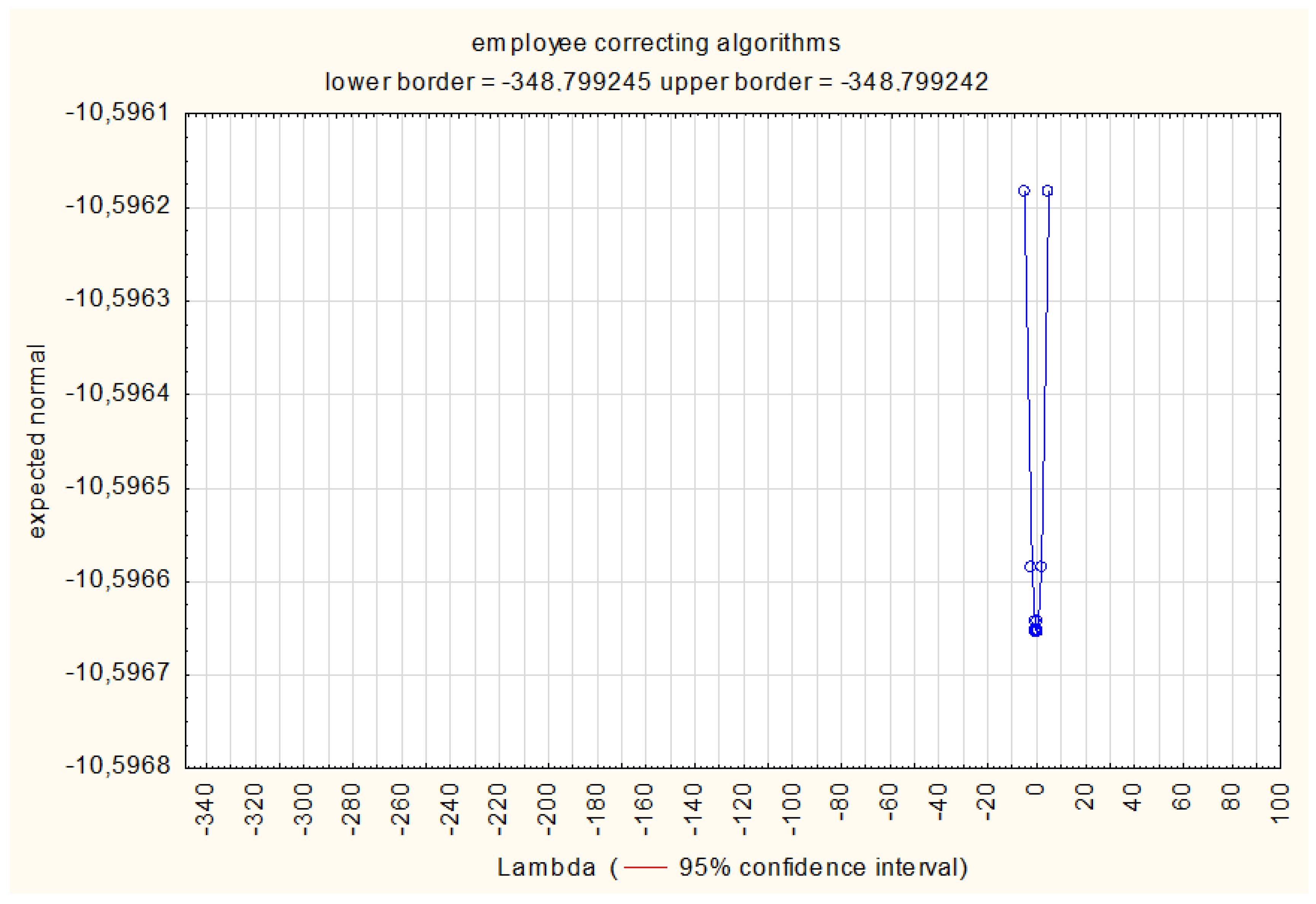
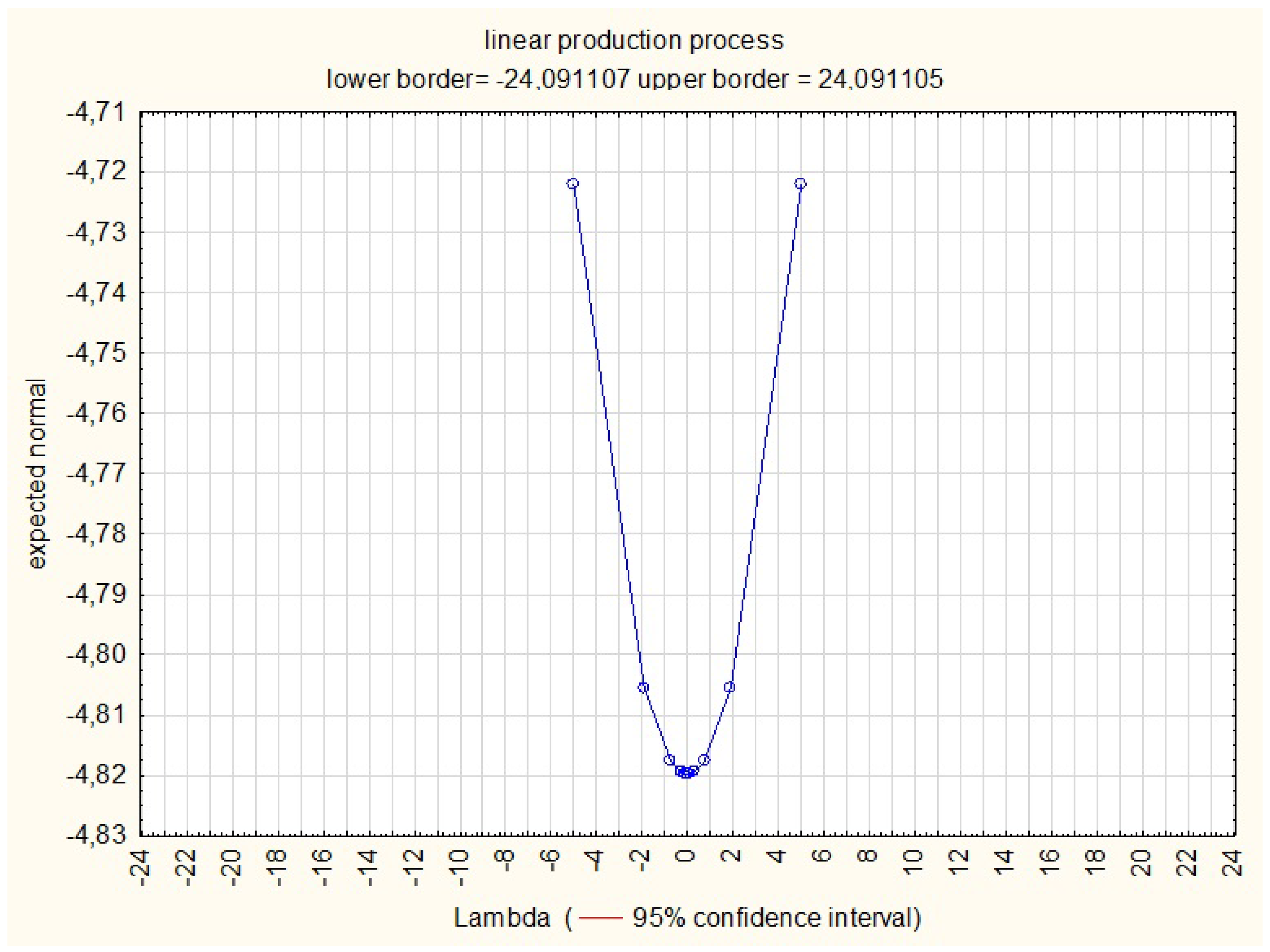
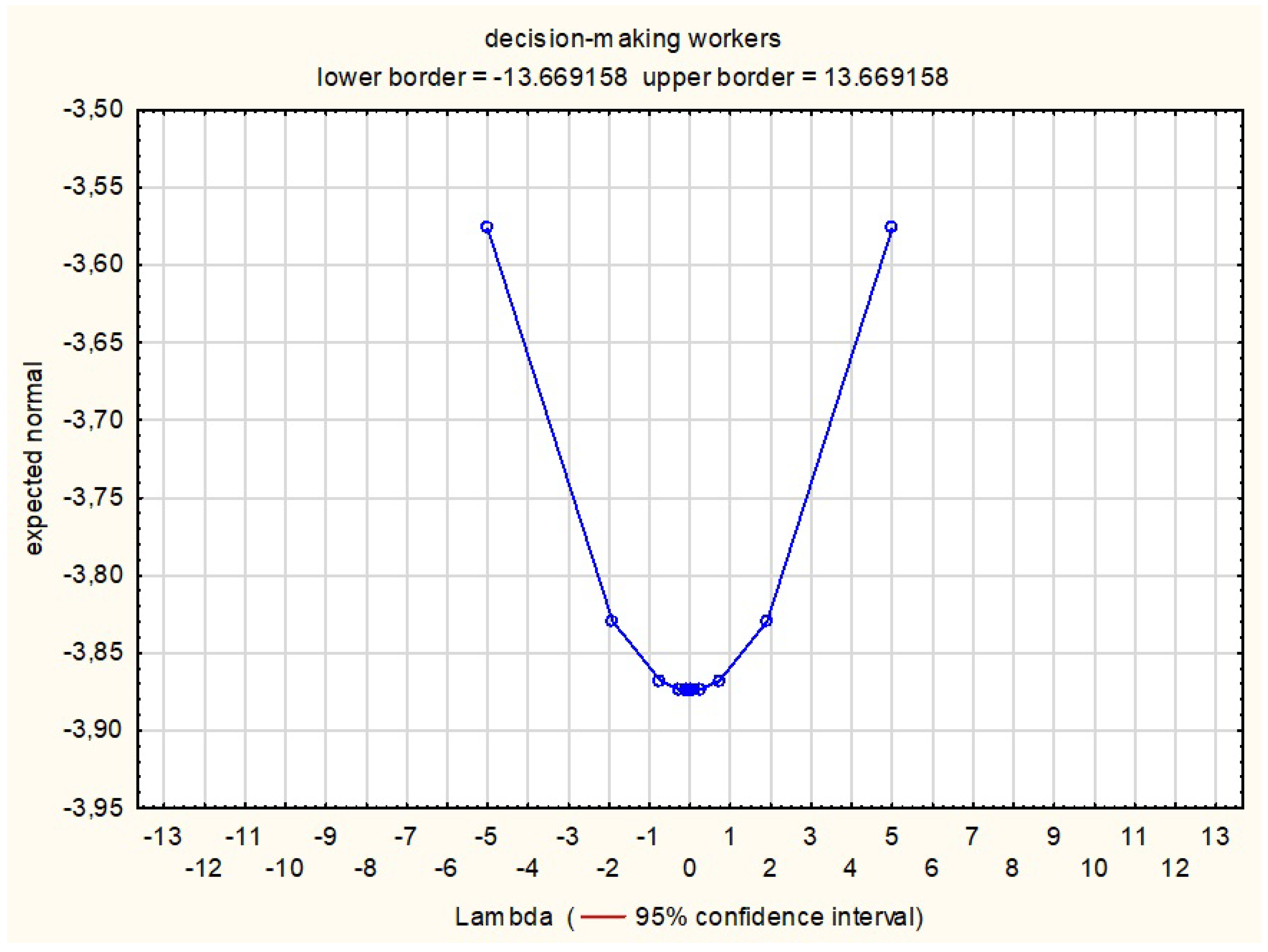
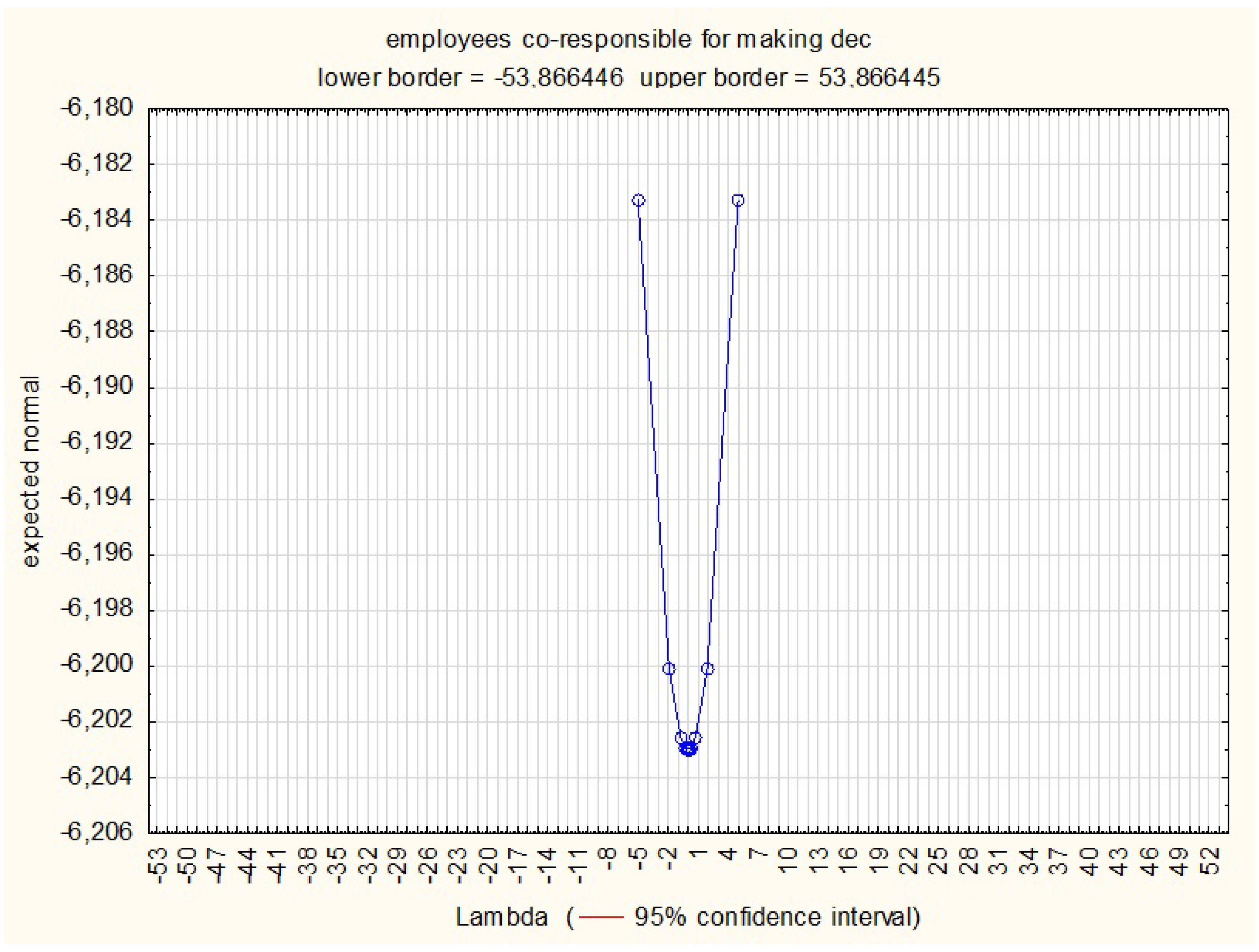
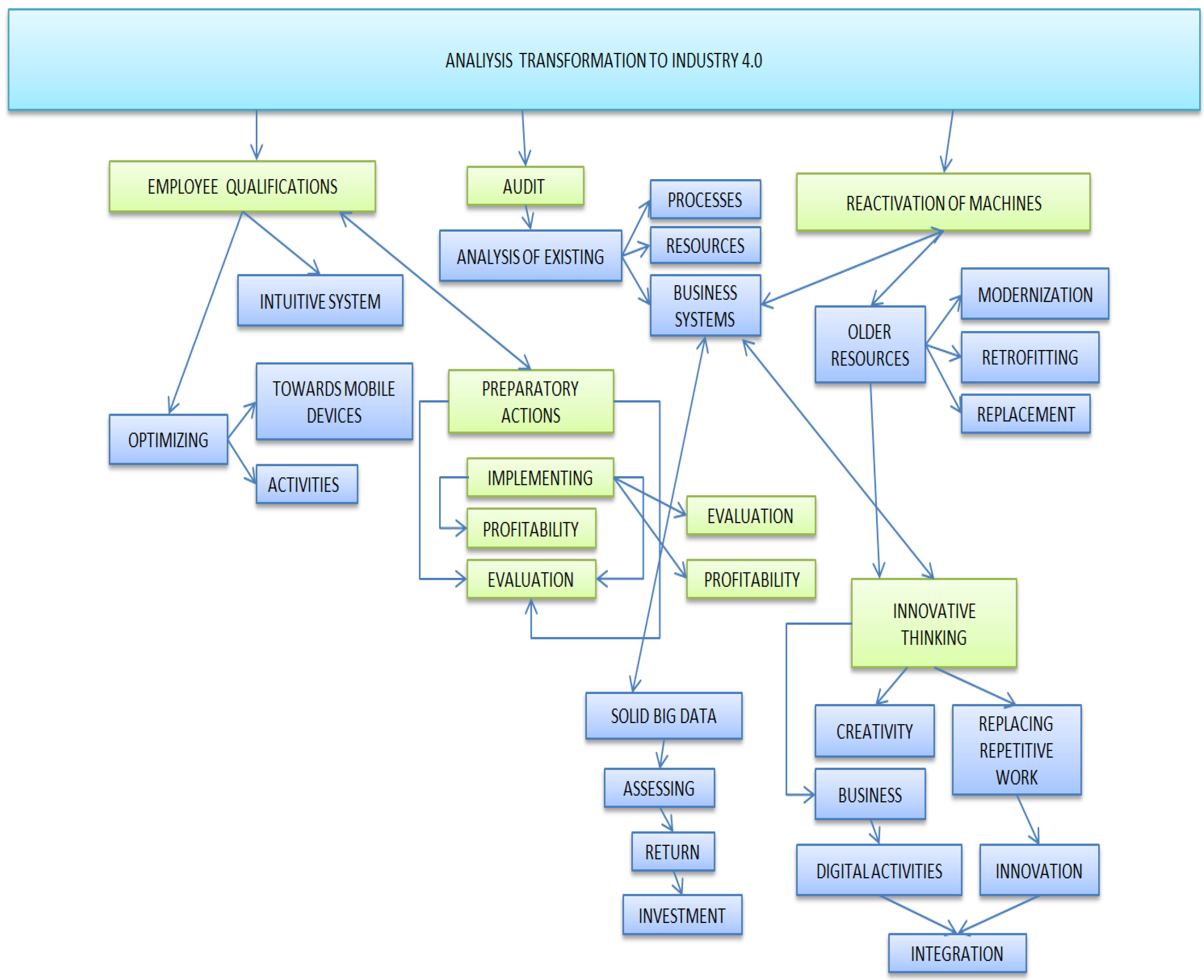

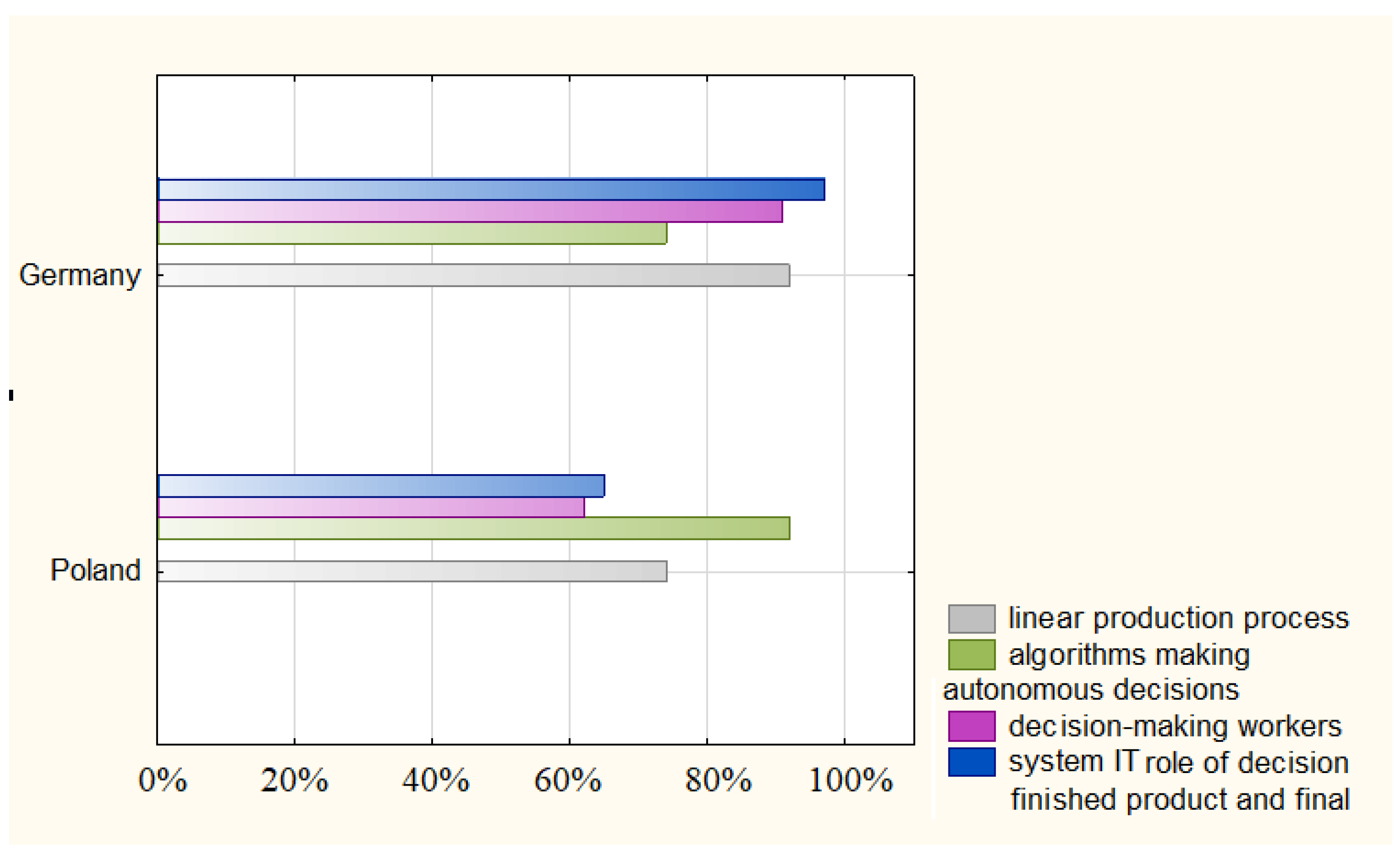
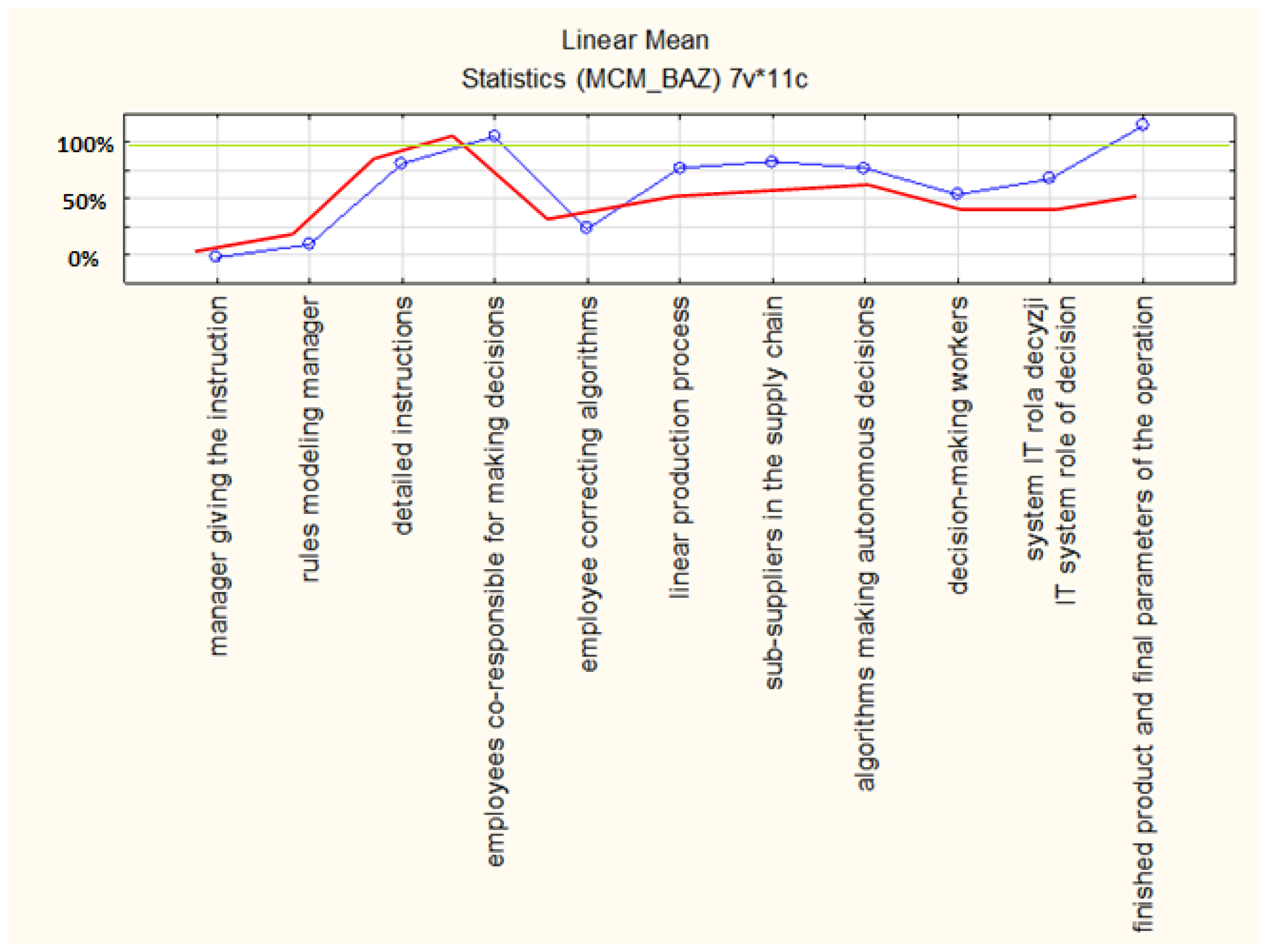
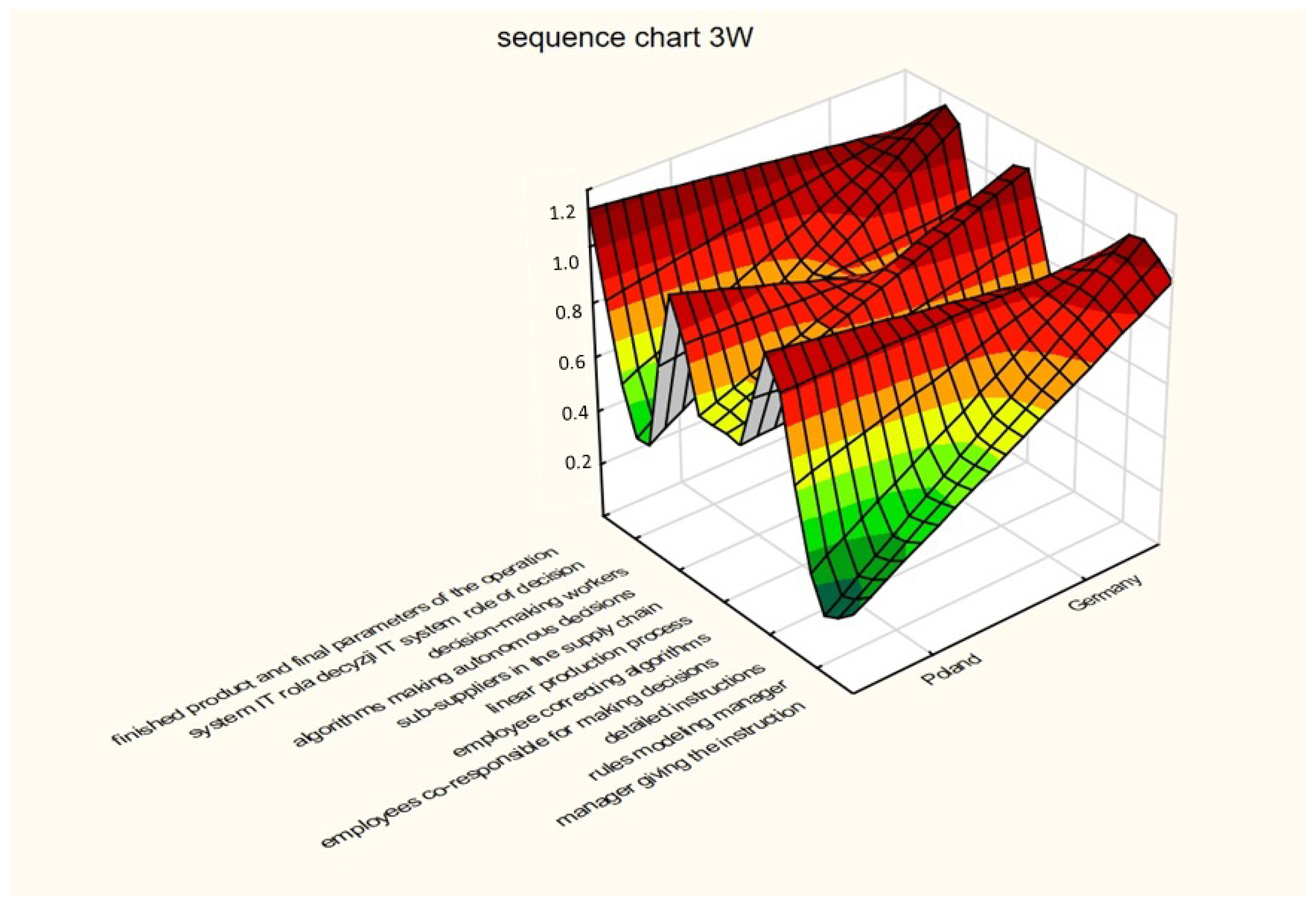
| The Course of Action | The Implementation Process |
|---|---|
| Communication [50] | Project teams rarely communicate with each other. Communication is only informal and uncoordinated. The role of communication channels through collaboration tools on separate/one-off tasks and projects has been reduced to one-time contacts. |
| Sales service solution [51] | Sales communication with customers takes place via traditional (offline) channels, and the technological level does not allow for personalization of content, communication channels, offers, and products. |
| Solution implementation strategy [52,53] | Building a strategy is not considered an important goal in the company’s current or future plans. |
| Scope of operation [54] | A long-term strategy and an appropriately adjusted management model have been implemented in at least one area of activity. |
| Training [55] | We do not train our employees. We train our selected employees when the situation in the market and the company require it. We have a training program focused on the continuous development of employees’ skills. |
| Knowledge [56] | The Management Board does not have an established and full knowledge of the latest solutions and is unable to implement them effectively. |
| Processes [57] | The processes are managed centrally and implemented by ad hoc methods by employees, without the use of advanced IT systems. |
| Planning [58] | No resource planning and production processes. |
| Product life cycle [59] | No product life cycle management. |
| Feature of the Industrial System | Industry Symbol |
|---|---|
| Manager giving the instruction | 2.0 |
| Manager who sets goals | 3.0 |
| Rule-modeling manager | 4.0 |
| Detailed instructions | 2.0 |
| Employees co-responsible for making decisions | 3.0 |
| Employee correcting algorithms | 4.0 |
| Linear production process | 2.0 |
| Sub-suppliers in the supply chain | 3.0 |
| Algorithms making autonomous decisions | 4.0 |
| Decision-making workers | 2.0 |
| IT system role of decision | 3.0 and 4.0 |
| Symbol | LM | L | R | La | Ra | γ |
|---|---|---|---|---|---|---|
| a | −0.000007 | −0.509717 | 0.440196 | −8.426 | 8.426 | ((v1^(−0.000007))−1)/(−0.000007) |
| b | 0.000007 | −0.463675 | 0.442439 | −8.383 | 8.383 | ((v2^(0.000007))−1)/(0.000007) |
| c | −0.000060 | −0.176912 | 0.101189 | −36.654 | 36.654 | ((v3^(−0.000060))−1)/(−0.000060) |
| d | −0.000126 | −0.079147 | 0.068855 | −53.866 | 53.866 | ((v4^(−0.000126))−1)/(−0.000126) |
| e | −0.000409 | −0.408031 | 0.010635 | −348.799 | −348.799 | ((v5^(−0.000409))−1)/(−0.000409) |
| f | −0.000048 | −0.192245 | 0.153955 | −24.091 | 24.091 | ((v6^(−0.000048))−1)/(−0.000048) |
| g | 0.000046 | −0.168155 | 0.150302 | −24.676 | 24.676 | ((v7^(0.000046))−1)/(0.000046) |
| h | −0.000048 | −0.192245 | 0.153955 | −24.091 | 24.091 | ((v8^(−0.000048))−1)/(−0.000048) |
| i | 0.000011 | −0.286173 | 0.271334 | −13.669 | 13.669 | ((v9^(0.000011))−1)/(0.000011) |
| j | −0.000018 | −0.230622 | 0.283073 | −13.102 | 13.102 | ((v10^(−0.000018))−1)/(−0.000018) |
| k | −0.000156 | −0.041691 | 0.058960 | −62.906 | 62.906 | ((v11^(−0.000156))−1)/(−0.000156) |
Publisher’s Note: MDPI stays neutral with regard to jurisdictional claims in published maps and institutional affiliations. |
© 2022 by the authors. Licensee MDPI, Basel, Switzerland. This article is an open access article distributed under the terms and conditions of the Creative Commons Attribution (CC BY) license (https://creativecommons.org/licenses/by/4.0/).
Share and Cite
Jałowiec, T.; Wojtaszek, H. Analysis of Directional Activities for Industry 4.0 in the Example of Poland and Germany. Sustainability 2022, 14, 3848. https://doi.org/10.3390/su14073848
Jałowiec T, Wojtaszek H. Analysis of Directional Activities for Industry 4.0 in the Example of Poland and Germany. Sustainability. 2022; 14(7):3848. https://doi.org/10.3390/su14073848
Chicago/Turabian StyleJałowiec, Tomasz, and Henryk Wojtaszek. 2022. "Analysis of Directional Activities for Industry 4.0 in the Example of Poland and Germany" Sustainability 14, no. 7: 3848. https://doi.org/10.3390/su14073848
APA StyleJałowiec, T., & Wojtaszek, H. (2022). Analysis of Directional Activities for Industry 4.0 in the Example of Poland and Germany. Sustainability, 14(7), 3848. https://doi.org/10.3390/su14073848








